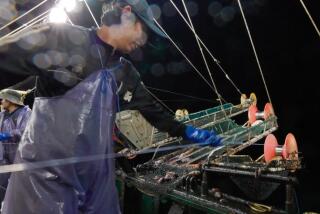Trolling for Fish-Oil Knowledge
- Share via
Federal researchers are in the final stages of selecting participants for a unique study designed to explore the relationship between diets naturally high in fish oils and blood clotting.
Awaiting those chosen for the project are 100 days in virtual confinement at the U.S. Department of Agriculture’s Western Human Nutrition Research Center on San Francisco’s Presidio.
For much of that time, 40 consecutive days, the subjects will be fed salmon at both lunch and dinner. The daily intake of fish during this portion of the study will average about a pound.
Participants Closely Monitored
Dietitians are doing their best to vary the 80 salmon meals by selecting fish-compatible presentations such as teriyaki, salads, lasagna and barbecue.
For the remainder of the study, the participants will eat a more varied selection. With or without the salmon, however, the subjects will be closely monitored.
The USDA scientists, led by research chemist Gary J. Nelson Ph.D., will try to determine exactly how fish oils, popularly known as Omega 3s, inhibit blood clotting. Previous research has indicated that this relationship may reduce the incidence of thrombosis, which can precipitate heart attack or stroke.
The project is distinguished by the fact that it is among the first to exclusively use fresh fish that might normally be found in the diet, rather than the more concentrated fish oil capsules, to explore Omega 3’s properties.
That may not be any consolation to the study’s 12 subjects, who are likely to endure some tediousness.
The volunteers, expected to come from throughout California, will be housed in the metabolic ward, said Marcia Wood, of the USDA’s Agricultural Research Service. There they will live under the watchful eye of the research and medical staff.
“They usually let them out for an escorted walk twice during the day or they are taken on an expedition to the museum, things like that,” she said. “It’s done for control, so that they won’t eat anything other than what’s on the menu.”
Allowed Use of Pool Table, Telephone
While in the metabolic ward, the subjects will have the use of a television, videocassette recorder, pool table and a pay phone.
The agency was inundated with 1,500 volunteers when word first surfaced that the USDA was about to embark on the study, with some of the inquiries coming from as far away as Tahiti, Paris and Stockholm. But as the specifics of the project became known, such as no conjugal visits, the interest dwindled.
Those selected are mostly Northern Californians, said Nelson, the study’s architect.
“They’re people who don’t hold ‘eight to five’ jobs, but they are not street people or those without resources,” he said. “Some are artists or people who can work while they are here. . . . Most are middle class.”
The researchers had originally wanted women for the study, but settled instead on men.
Recruiting a dozen females between ages 35 and 60 proved too time consuming, Nelson said.
“Most people are not willing to be incarcerated for 100 days in a metabolic unit,” he said.
The strict regimen is not without benefits. If the participants make it through the entire study they stand to earn $2,075. And, according to Wood, on the 100th day they get to eat anything they want.
A full range of medical care is also available to participants including one of the most important: psychological support.
Fugu to America--Japanese seafood firms have received permission to export the infamous fugu, or puffer fish, into the United States.
The fish, whose toxin claims several lives each year in Japan, is considered a delicacy.
Since 1980, the U.S. Food and Drug Administration had banned import of fugu because the species contained tetrodotoxin, a strong poison, for which there are no known antidotes.
The FDA’s change of heart was contingent upon importers meeting several restrictions that are designed to ensure adequate consumer safeguards.
The conditions were stipulated in an FDA letter to the Japanese Ministry of Health and Welfare, the contents of which were released last week.
Under the terms of the agreement, Japanese officials will play a major role in the process.
Import Guidelines
The import guidelines include limiting the species approved for consumption in this country to the tiger puffer, a variety that does not contain the toxin in the skin and meat. The liver and ovaries, where the poison concentrates, must be removed only by those licensed by the Japanese government to clean the fish.
After processing, the filet must be certified as free of tetrodotoxin by a Japanese food sanitation inspector. All fish must then be flash frozen and shipped only by air freight to the United States.
Each shipment must carry complete documentation, including location where caught, the names of the individual who worked on the fish and the government inspector.
Firms will only be permitted to export tiger puffer to this country between the months of September and March, according to the agreement.
Those who handle the fish must undergo extensive training before being licensed by the Japanese government to clean fugu. In fact, most deaths associated with the fish occur because the puffer was prepared by amateurs, according to one industry trade journal’s account.
Ironically, the import of fugu comes at a time when consumer advocacy groups have charged that the U.S. government is not doing enough to ensure safe and wholesome seafood supplies.






